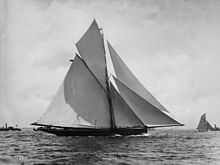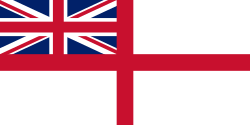Royal Yacht Squadron
| RYS | |||
| |||
| Voller Name | Royal Yacht Squadron | ||
| Gegründet | 1. Juni 1815 in London | ||
| Vereinssitz | Cowes Castle, Isle of Wight | ||
| Vorsitzender | Timothy James Ralph Sheldon | ||
| Commodore | Timothy James Ralph Sheldon | ||
| Homepage | http://www.rys.org.uk | ||

Der Club Royal Yacht Squadron (RYS) (deutsch Königliches Yacht Geschwader) gilt als der altehrwürdigste Yachtclub Großbritanniens. Das Clubhaus befindet sich im Cowes Castle auf der Isle of Wight. Die Yachten der Mitglieder führen den Zusatz RYS in ihren Namen und haben seit einer Verfügung der britischen Admiralität aus dem Jahr 1829 das Privileg, als einzige Zivilfahrzeuge statt der Nationalflagge (Red Ensign) die Seekriegsflagge White Ensign der Royal Navy setzen zu dürfen. Der Stander wird in der Regel im Großmasttop gesetzt und die Flagge am Heck der Yacht.
Geschichte

Am 1. Juni 1815 wurde der Club als The Yacht Club in der Kneipe Thatched House Tavern in St James’s, London gegründet, um der eleganten Oberschicht des Vereinigten Königreichs eine stilvolle Möglichkeit zum Sportsegeln zu bieten. 1817 wurde der spätere König Georg IV. als Mitglied aufgenommen und vom ersten „Commodore“ des Clubs willkommen geheißen. Daraufhin erfolgte die Umbenennung des Yachtclubs in Royal Yacht Club. Die Cowes Week entstand und wurde vom Royal Yacht Club maßgeblich mitorganisiert. 1833 erhielt der Verein den heutigen Namen The Royal Yacht Squadron (RYS).
Zu den frühen Mitgliedern gehörte Thomas Masterman Hardy (Nelson’s Hardy) und weitere Marineoffiziere, was die enge Beziehung zwischen Royal Yacht Squadron und der Royal Navy begründete.
1851 veranstaltete die Royal Yacht Squadron eine offene Wettfahrt auf der Regattabahn The Queens Course rund um die Isle of Wight herum. Start und Ziel war auf dem Solent. Für den Sieg war der von Lord Anglesey gestifteten Pokal One Hundred Sovereigns Cup ausgelobt, da der Pokal beim Londoner Juwelier R. & G. Garrard 100 Sovereigns gekostet hatte. Die New Yorker Schoner-Yacht America war auf Einladung des Kommodore Thomas Egerton, 2. Earl of Wilton (Lord Wilton) nach Großbritannien gekommen, gewann die Wettfahrt überlegen und wurde zur Namensgeberin des America’s Cup, der zum ersten Mal 1870 vor New York ausgetragen wurde.[1]
Die RYS Gazelle evakuierte nach dem Deutsch-Französischen Krieg die Kaiserin Eugénie. Yachten der Royal Yacht Squadron versorgten für die Royal Navy Soldaten im Krimkrieg.[2]
Mit der Meteor nahm der deutsche Kaiser Wilhelm II. zum ersten Mal 1892 mit einer eigenen Segelyacht an der internationalen und prestigeträchtigen Regattawoche von Cowes, der Cowes Week, teil. Sein Erscheinen in Cowes und im Clubhaus des Royal Yacht Squadron veranlasste seinen Onkel, den Prince of Wales und späteren Königs des Vereinigten Königreichs von Großbritannien und Irland Eduard VII., auch eine Regattayacht Britannia auf derselben schottischen Bauwerft der ehemaligen Thistle in Auftrag zu geben.
Im Jahr 2000 wurde ein von Sir Thomas Croft entworfener Pavillon eröffnet, der den Vereinsmitgliedern offensteht und darüber hinaus 2001 die Feierlichkeiten zum 150. Jubiläum des America’s Cup beherbergte.
RYS Flag Officers
Admiral
König William IV. wurde der erste Admiral des Royal Yacht Squadron. Er war es, der den noblen Segelclub mit dem Namen im Jahr 1833 auszeichnete. Er setzte sich auch selbst an seine Spitze. Nach dem Tode von Queen Victoria wurde die Idee des Admirals der Royal Yacht Squadron wiederbelebt, da der amtierende Kommodore des Clubs HRH The Prince of Wales nun selbst König Eduard VII. wurde. Die Regelung, dass der amtierende britische Monarch Admiral oder Patron des Royal Yacht Squadron wurde, hält bis in die heutige Zeit an. König Charles III. ist daher Patron des Royal Yacht Squadron.
Kommodore (Commodore)
Die Kommodore dienten dem Club regelmäßig nach ihrer Ernennung bis zu ihrem Tode. Die zu diesem Zeitpunkt aktiven Vizekommodore versuchten, die Position des Kommodore zu übernehmen, sobald dieser aufhörte. Diese Tradition wurde geändert als Sir Ralph Gore im Jahre 1961 verstarb. Zu diesem Zeitpunkt sollte HRH The Prince Philip, Duke of Edinburgh, das Amt des Kommodore übernehmen. Man beschränkte fortan die Dienstzeit als Kommodore auf eine feste Amtszeit von sechs Jahren. Danach wurde die Amtszeit für einen Kommodore und einen Vizekommodore zuerst auf fünf und dann auf vier Jahre verkürzt.[3]
- 1825–1846 The Earl of Yarborough
- 1847–1848 The Marquess of Donegall
- 1849–1881 The Earl of Wilton
- 1882–1900 HRH The Prince of Wales
- 1901–1919 The Marquess of Ormonde
- 1920–1926 The Duke of Leeds
- 1927–1942 Sir Richard Williams-Bulkeley
- 1942–1943 The Marquess Camden
- 1943–1947 Sir Philip Hunloke
- 1947–1961 Sir Ralph Gore
- 1962–1968 HRH The Prince Philip Duke of Edinburgh
- 1968–1974 The Viscount Runciman of Doxford
- 1974–1980 The Earl Cathcart
- 1980–1986 Sir John Nicholson
- 1986–1991 John Roome
- 1991–1996 Maldwin A. C. Drummond
- 1996–2001 Peter C. Nicholson
- 2001–2005 The Lord Amherst of Hackney
- 2005–2009 The Lord Iliffe
- 2009–2013 M.D.C.C. Campbell
- 2013–2017 Christopher Sharples
- seit 2017 Timothy James Ralph Sheldon
Vizekommodore (Vice Commodore)
- 1827–1847 The Earl of Belfast/The Marquess of Donegall
- 1848–1850 Sir Bellingham Graham
- 1851–1861 C. R. M. Talbot
- 1862–1875 The Marquess Conyngham
- 1876–1884 The Marquess of Londonderry
- 1885–1900 The Marquess of Ormonde
- 1901–1919 The Duke of Leeds
- 1920–1926 Sir Richard Williams-Bulkeley
- 1927–1943 The Marquess Camden
- 1945–1947 Sir Ralph Gore
- 1948–1954 William Berry, 1. Viscount Camrose
- 1954–1965 The Marquess Camden
- 1965–1971 Sir Kenneth Preston
- 1971–1977 The Earl of Malmesbury
- 1977–1983 Sir Robert Pigot
- 1983–1988 Sir Charles Tidbury
- 1988–1993 A. J. Sheldon
- 1993–1998 The Lord Amherst of Hackney
- 1998–2003 Michael D. C. Campbell
- 2003–2007 Sir Nigel Southward
- 2007–2011 Ian Laing
- 2011–2015 C. R. Dick
- seit 2015 Colin Campbell
Konterkommodore (Rear Commodore)
- 1962–1964 The Earl Cathcart
- 1962–1966 The Viscount Runciman of Doxford
- 1964–1968 A. W. Acland
- 1966–1970 John D. Russell
- 1968–1972 Stewart H. Morris
- 1970–1974 Roger Leigh-Wood
- 1972–1976 P. R. Colville
- 1974–1978 Sir Richard Anstruther-Gough-Calthorpe
- 1976–1980 J. M. F. Crean
- 1978–1982 Sir Eric Drake
- 1980–1984 J. W. Roome
- 1982–1986 Sir Maurice Laing
- 1984–1988 G. H. Mann
- 1986–1990 J. R. D. Green
- 1988–1992 D. A. Acland
- 1990–1994 P. C. Nicholson
- 1992–1996 A. K. S. Franks
- 1994–1998 A. H. Matusch
- 1996–2000 D. F. Biddle
- 1998–2002 J. H. P. Cuddigan
- 2000–2004 R. W. C. Colvill
- 2002–2006 John Grandy
- 2004–2008 John Godfrey
- 2006–2010 S. A. V. van der Byl
- 2008–2012 John Raymond
- 2010–2014 David Aisher
- 2012–2016 Patrick Seely
- 2014–2018 J. P. L. Perry
- seit 2016 C. Russell
- seit 2018 Robert M. Bicket
Weblinks
- offizielle Website des Royal Yacht Squadron (engl.)
- YouTube: Royal Yacht Squadron Bicentenary, 2016, (engl.)
Einzelnachweise
- ↑ Royal Yacht Squadron: The Yacht America ( vom 16. Oktober 2008 im Internet Archive). Abgerufen am 27. Januar 2009.
- ↑ rys - Yachts, Yachtsmen and the Crimean War (2013). Abgerufen am 27. September 2021.
- ↑ RYS Flag Officers (engl.) Abgerufen am 22. Februar 2009
Auf dieser Seite verwendete Medien
Autor/Urheber: Ronald Saunders from Warrington, UK, Lizenz: CC BY-SA 2.0
The Royal Yacht Squadron is one of the most prestigious yacht clubs in the world. Its clubhouse is Cowes Castle on the Isle of Wight in the United Kingdom. Member yachts are given the Suffix RYS to their names, and permitted to fly the White Ensign of the Royal Navy[1] rather than the merchant Red Ensign flown by the majority of other UK registered vessels. The club's patron is Queen Elizabeth II and the club’s admiral is Prince Philip who is also a former club commodore.
Founded on 1 June 1815 in the Thatched House Tavern in St James’s, London as The Yacht Club by 42 gentlemen interested in sea yachting.[2] The original members decided to meet in London and in Cowes twice a year, to discuss yachting over dinner. Membership was restricted to those who owned a vessel not under 10 tons. Today this is interpreted as a gentleman “actively interested in yachting”.[1]
The Earl of Yarborough, later first commodore of the club, welcomed the Prince Regent as a member in 1817. In 1820, when the Prince Regent became George IV, it was renamed the Royal Yacht Club.
The club started organising racing as a principal feature of the annual regatta, which is now known as Cowes Week. In 1833 William IV renamed the club, The Royal Yacht Squadron. Its association with the Royal Navy began early and Nelson's captain at Trafalgar, Admiral Sir Thomas Hardy, headed the list of naval members. The spirit of invention led to yachts “of such celerity in sailing and beauty of construction” that they were of utility to the Royal Navy. In 1829 the Admiralty issued a warrant to wear what is now the navy’s White Ensign. The burgee (a triangular shaped flag identifying yacht club membership) is differenced with a St George's Cross and crown on a white background.
Another naval connection is that the Antarctic explorer Captain Scott was a member of the Royal Yacht Squadron. To enable the application of naval discipline on board a civilian ship, he registered the Terra Nova R.Y.S. as a yacht of the squadron and sailed under the White Ensign on his second and final expedition to Antarctica in 1910. Racing Genesta (1885), the club's first challenger for the America's Cup
In 1851, the club's commodore, visiting the Great Exhibition, issued a challenge for the squadron’s £100 Cup for a race around the island. The New York based ‘’America’’, representing the New York Yacht Club triumphed in this race giving its name to one of the oldest and best known trophies The America's Cup. The victory was witnessed by Queen Victoria and the Prince of Wales, later commodore of the club and Edward VII.
The site is also used as the start of the Round the Island Race which occurs annually.
During the American Civil War Deerhound RYS witnessed the fight between USS Kearsarge and the Confederate cruiser CSS Alabama. Gazelle RYS rescued the Empress Eugenie at the end of the Franco-Prussian War and the squadron yachts supplied British soldiers in the Crimean War.
The German Kaiser brought the 1887 America’s Cup challenger Thistle, to Cowes in 1892 which encouraged the Prince of Wales to build Britannia, one of the most successful racing yachts of all time.Sir Richard Sutton's cutter Genesta, 1885 challenger of the America's Cup (John Beevor-Webb design, 1884)





